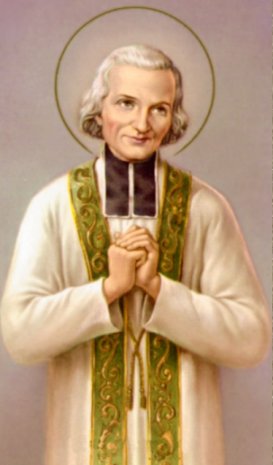Saint John Vianney

1786-1859
Fest day: August 4
Better known as Pastor van Ars
Jean Baptiste Marie Vianney or Johannes Maria Vianney, also called the Curé of Ars, was born on May 8, 1786 in the village of Dardilly near Lyon (France) from a poor peasant family. His childhood years would have a strong influence on his spiritual life as a priest. The religious beliefs of his parents, especially his mother's, would give rock solid faith to this simple but thoroughly good farm boy. He would learn to pray in the parental home. He made his First Holy Communion in secret when he was 13 years old, because the Church was still persecuted at that time.
He worked as a shepherd until he was 18 and then started studying to be a priest. This was a very difficult time for Johannes Maria Vianney. He was a mediocre student. He didn't understand the Latin lessons. However, as he excelled in piety and evangelical simplicity, he was nevertheless ordained to the priesthood in 1815 and sent to Éculy as chaplain. When Pastor Balley died there, Johannes Maria Vianney was appointed to Ars-sur-Formans, a small village near Lyon in the current department of Ain. It is in February 1818, probably the 11th, that Johannes Maria Vianney arrived in Ars.
The spiritual life in the village of Ars-sur-Formans had fallen into disrepair in the background of the French Revolution. His parishioners mocked their new pastor and tried to blacken him. How the villagers had laughed at their new pastor, who couldn't get his words out and cried during his sermons. Yet they became curious, for it was whispered that he was a saint. He gave away everything the parish owned. "Give everything and keep nothing" was his secret. A normal person could not live on what he ate and he beat himself to the point of bleeding.
He made every effort to give adequate religious instruction to his parishioners. Catechesis to youth was his primary concern. Another favorite form of teaching for the Curé of Ars was the sermon. In the early morning he preached to an empty church, by way of practice. The Pastor became widely known as a confessor. People came from all over France to confess to the Curé d'Ars, to ask him a favor or advice. He spent many hours a day in the confessional.
During the last years of his life, about 100,000 pilgrims came to Ars every year to receive a word of encouragement and peace from that humble pastor who, perhaps, did not know much about human science or even theology, but who at least knew the hearts of men and the heart of God. The “Heart of God”, which he made known and experienced in the Sacrament of Reconciliation, but also in his sermons. Countless sinners were converted by him. He also healed many sick people
After 41 years of service as a priest in Ars, Johannes Maria Vianney died in Ars on August 4, 1859, after a life of penance and prayer without neglecting his daily duties as a priest and pastor. Very soon after his death, a process for his beatification was opened in the Diocese of Belley, to which he belonged. Curé van Ars was beatified in 1905 by Pope Pius X and canonized in 1925 by Pius XI. In 1929 he was named Patron of Parish Priests. Pope Benedict XVI declares him the universal patron of all priests worldwide during this Year of the Priesthood.
After the beatification in 1905, the intact body of the priest of Ars was exhumed. The face was covered with a layer of wax and so the Vicar of Ars can still be seen in a glass coffin for everyone in the Basilica in the town of Ars. His heart is kept in a separate shrine in the heart chapel in Ars. The relic of the heart has also been in other places; she was in Rome with Pope Benedict XVI in May 2005. During the month of August she was in Cologne during the World Youth Day. Today, the village of Ars-sur-Formans attracts 450,000 pilgrims a year.
Patron Saint: of all parish priests worldwide.
From RKNieuwsnet dated April 27, 2010 - Relics pastor of Ars in Ireland:
Since Sunday, the relics of Johannes Maria Vianney, the St. Curé of Ars, have been in Ireland. This is reported by the Catholic news agency Zenit. The relics were brought to Ireland as part of the Year of the Priest. They are on display in Cork, Dublin, Knock and Armagh.